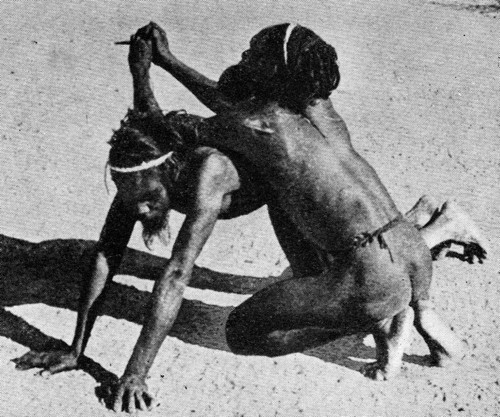Rituals and Superstitions
Edgar Larkin
I'm always fascinated by scientists who are also bonkers about the supernatural. Even Isaac Newton dabbled in the occult, which was more understandable for his era.But here's a twentieth-century fellow who led such a double life: Edgar Lucien Larkin.
I'm sure you will want to read all 366 pages of his masterwork to be found here.


Posted By: Paul - Mon Dec 03, 2012 -
Comments (4)
Category: Eccentrics, New Age, Religion, Rituals and Superstitions, Science, 1900s
What’s the origin of the Boy Scout’s left-hand handshake?
As the 1935 Boy Scout handbook says, "By agreement of the Scout Leaders throughout the world, Boy Scouts greet Brother Scouts with a warm left hand clasp." (wikipedia). But what's the origin of this form of greeting?
Lord Baden-Powell, founder of the Boy Scouts, claimed he learned the custom from a defeated African chieftain whom he attempted to greet in 1896 by holding out his right hand. The chieftain supposedly replied: "The men in my tribe greet the bravest with the left hand." There are different versions of this story, but I think all of them can safely be dismissed as bogus.
There's also a theory that the scouts shake with their left hand because it's the hand closer to the heart. I also doubt this theory.
I think the real origin traces back to Baden-Powell's passion for promoting ambidexterity — and not just the ability to use either hand with equal dexterity, but to use both hands for different tasks, simultaneously.
Baden-Powell expressed some of these views in the brief introduction he wrote to John Jackson's 1905 book Ambidexterity, or, Two-handedness and two-brainedness:
It is hardly possible to lay too much stress upon this bimanual training, or to attach too much important to the principke, because our hands -- and our arms, from which, for purposes both of argument and education, they cannot be separated -- not only constitute our chief medium of communication with the outer world, but they are likewise the pre-eminent agency by which we stamp our impress upon it...
The heavy pressure of my office work makes me wish that I had cultivated, in my youth, the useful art of writing on two different subjects at once. I get through a great deal extra -- it is true -- by using the right and left hand alternately, but I thoroughly appreciate how much more can be done by using them both together.
Posted By: Alex - Thu Aug 02, 2012 -
Comments (7)
Category: Customs, Rituals and Superstitions
Bone Pointing
--from "Primitive Theories of Disease" by Spencer L. Rogers in Ciba Symposia (April 1942)
Shown below are two Australian Arunta men demonstrating how to point the bone at someone. Wikipedia adds an interesting piece of trivia:

Posted By: Alex - Fri Jun 15, 2012 -
Comments (5)
Category: Death, Rituals and Superstitions
Puerto Rican St. Pat’s Day

Do they still celebrate St. Patrick's Day with special fervor in Puerto Rico, thanking the saint for freedom from worms and ants? A charming thing, if they do.
Original article here.
Posted By: Paul - Thu Mar 15, 2012 -
Comments (6)
Category: Holidays, Insects and Spiders, Religion, Rituals and Superstitions, 1920s, Caribbean
The Spittle Burier
Sir James Frazer's Golden Bough (1922) is full of curious information -- including his description of a very strange occupation, the spittle burier:Even though the guy was burying spittle, he probably thought he was doing a pretty important job. And in his culture, perhaps he was.
The portrait below shows Kaneena, a chief of the Sandwich Islands in the late eighteenth century, whose spittle would presumably have been buried.

Posted By: Alex - Thu Feb 16, 2012 -
Comments (5)
Category: Rituals and Superstitions
Fijian Cannibal Forks
If you're ever at a dinner party where the host has a set of forks that look like these, you might want to consider leaving, quickly.
These are Fijian "cannibal forks" used for eating human flesh. The iron dance blog offers this description of them:
Fijian cannibal forks are still made, to sell to tourists. What the tourists use them for... I guess that's their own business.
Posted By: Alex - Wed Feb 15, 2012 -
Comments (6)
Category: Cannibalism, Food, Rituals and Superstitions
Branded!
This TV theme song and imagery has stuck with me since childhood. It's undeniably powerful still, I think.
But who knew that the armed forces today still do the same thing? Read about the Canadian response to the conviction of a twisted soldier.
Posted By: Paul - Sat Nov 20, 2010 -
Comments (6)
Category: Crime, Public Humiliation, Rituals and Superstitions, Television, 1960s, Armed Forces

| Who We Are |
|---|
| Alex Boese Alex is the creator and curator of the Museum of Hoaxes. He's also the author of various weird, non-fiction, science-themed books such as Elephants on Acid and Psychedelic Apes. Paul Di Filippo Paul has been paid to put weird ideas into fictional form for over thirty years, in his career as a noted science fiction writer. He has recently begun blogging on many curious topics with three fellow writers at The Inferior 4+1. Contact Us |




